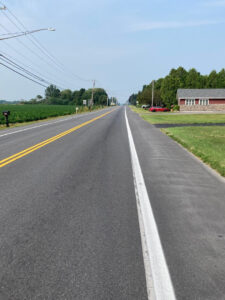Forward blind zones are getting worse
Today’s passenger vehicles generally are stylish, sleek and aerodynamic. But six of the top-selling vehicles have a major design flaw — forward blind zones. According to a comparison technique developed by the Insurance Institute for Highway Safety (IIHS), the forward blind zones grew substantially over the past 25 years at the same time pedestrian and bicyclist fatalities soared. Coincidence?
A recent study led by researchers from the U.S. Department of Transportation’s Volpe Center is the first to use the new IIHS method for measuring a driver’s direct area of vision around a vehicle. The technique should lead to broader studies of the role vehicle design plays in driver visibility and crash risk. Over multiple redesign cycles from 1997 to 2023, researchers found that forward visibility within a 10-meter radius fell as much as 58% for three popular SUVs.
IIHS President David Harkey said, “The across-the-board decrease in visibility for this small group of models is concerning. We need to investigate whether this is a broader trend that may have contributed to the recent spike in pedestrian and bicyclist fatalities.”
“This study also illustrates that the new method developed by IIHS gives researchers a straightforward, repeatable way to assess driver visibility,” he added. In the past, researchers who wanted to compare the blind zones of different models needed to acquire engineering drawings or position each vehicle in an open area specially marked with grid lines or traffic cones. Because these methods were so cumbersome, large-scale comparisons were not attempted.
The new IIHS method relies on computational software and a portable camera rig that can be positioned in the driver seat at various heights to represent different-sized drivers. The camera rotates to take a 360-degree image of the field of vision around the vehicle. The software then converts that image into a blind zone map that depicts an aerial view of the vehicle and the nearest points on the ground that the driver can see. It also provides a numerical value for the percentage of the area around the vehicle that is visible.
The Volpe Center’s researchers used the new technique to examine how the designs of the Chevrolet Suburban, Ford F-150, Honda Accord, Honda CR-V, Jeep Grand Cherokee and Toyota Camry changed over model years 1997 to 2023 — an effort that required blind zone maps of 17 individual vehicles, representing each major redesign of the six study vehicles.
The Volpe Center study focused on forward visibility within a 10-meter radius of the vehicle because that is the average driver stopping distance at 10 mph, a low speed at which blind zones are a common factor in crashes. They calculated the percentage of the 180-degree area that was not obscured by obstacles such as the vehicle hood, the rearview mirror and the A-pillars. A-pillars are the structural support on either side of the windshield that connects the roof to the body of the vehicle.
The most dramatic reduction loss of visibility came in the Honda CR-V. That vehicle’s hood, mirrors and A-pillars all obstructed a greater portion of the driver’s view over time. Drivers of the 1997 model were able to see 68% of the area 10 meters in front of the vehicle, while drivers of the 2022 model could see only 28%.
While further research is needed to support or refute the early findings, car buyers should be aware of the limitations such shortcomings place on drivers.

